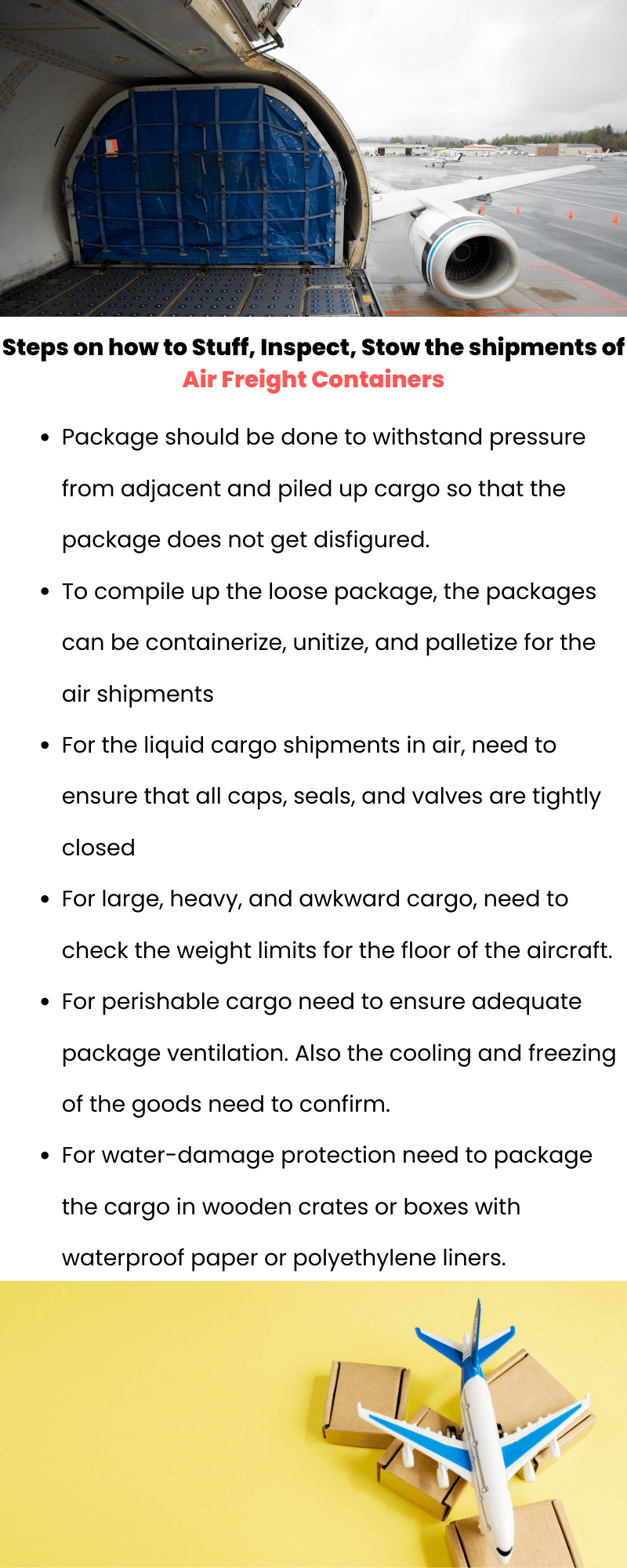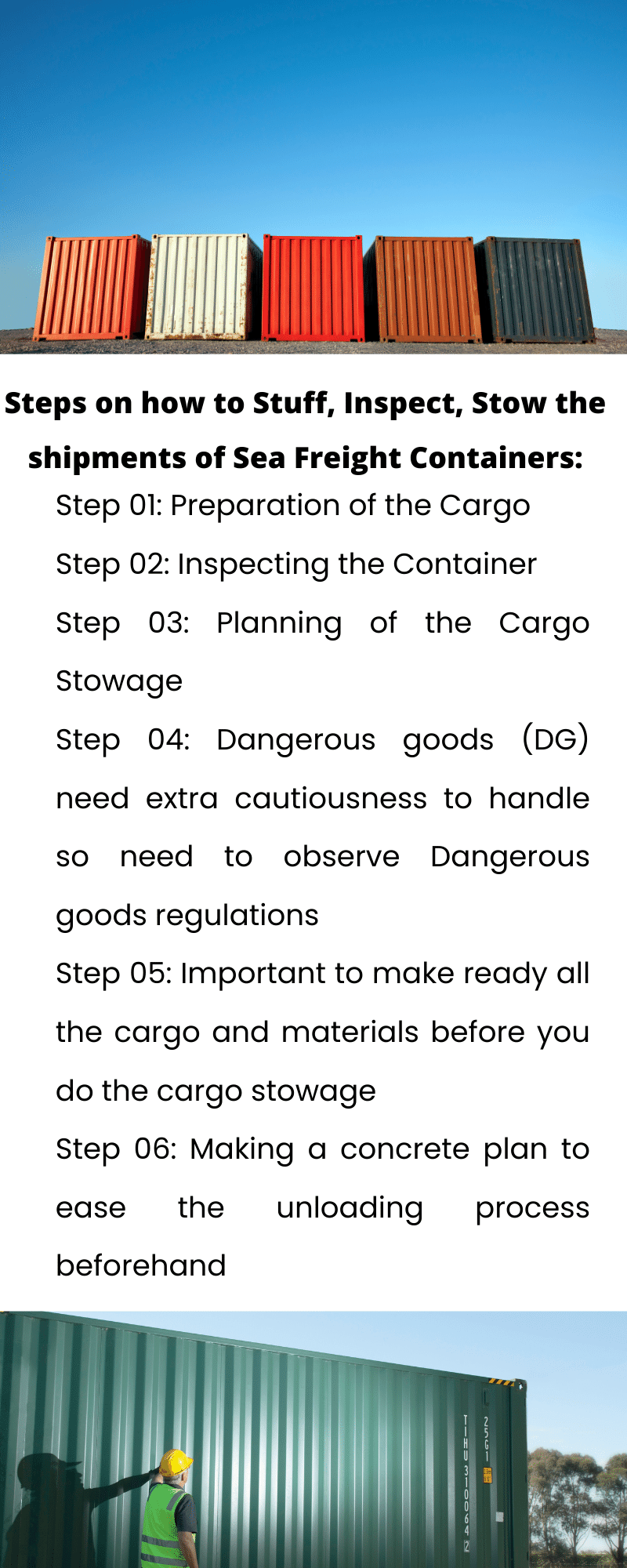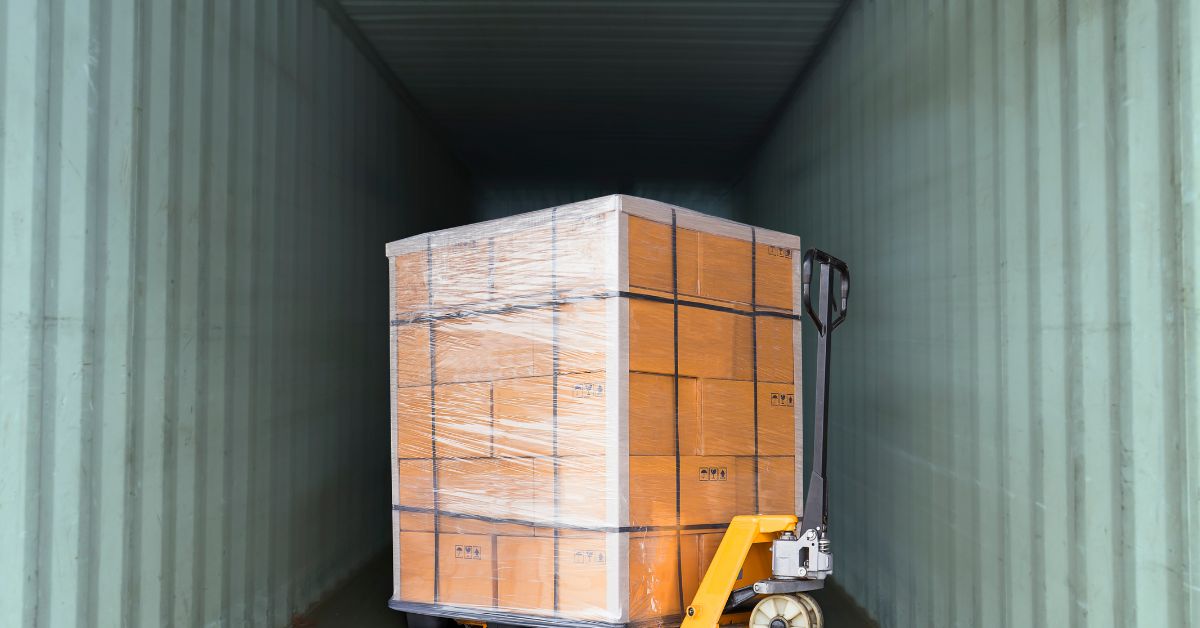In import and export trade, stuffing your goods in the right and secure way in the containers is one of the most important things. Below is a complete guide to Stuff, Inspect, Stow for Sea & Air freight containers.
Cargo stowage: The proper placement, distribution and packing of goods in a (cargo transport unit or CTU e.g. containers, pallets) for the shipment of the goods.
If not done properly in the containers while exporting then serious shipment causalities and damage may happen not only in sea or air flights but also during loading and unloading of the containers in the origin and discharge ports.
Table of Contents
- Steps on Complete Guide to Stuff, Inspect, Stow the shipments of Sea Freight Containers
- Step 01: Preparation of the Cargo
- Step 02: Inspecting the Container
- Step 03: Planning of the Cargo Stowage
- Step 04: Dangerous goods (DG) need extra cautiousness to handle so need to observe Dangerous goods regulations
- Step 05: Important to make ready all the cargo and materials before you do the cargo stowage
- Step 06: Making a concrete plan to ease the unloading process beforehand
- Detail Analysis on the process of completing the Sea Cargo Stowage
- 1. We must isolate the cargo from the Container Doors
- 2. Not exceeding the maximum weight that the container can carry
- 3. Providing the water-damage protection
- 4. Ensuring the cargo ventilation
- 5. Closing and sealing the container
- Steps on Complete Guide to Stuff, Inspect, Stow the shipments of Air Freight Containers.
- Let us see the air cargo packaging specifications
- Air Cargo Containerization
- Air cargo pallets
- Lower deck and main deck containers
Steps on Complete Guide to Stuff, Inspect, Stow the shipments of Sea Freight Containers
Step 01: Preparation of the Cargo
Make sure that the goods cannot move within the carton, wooden crate, drum, etc. in which they are packed. We must immobilize the contents by blocking and/or bracing, and provide adequate cushioning.
Heavy items, machinery, and items not uniform in shape or dimension should be crated, boxed, and/or provided with skids to permit ease of handling and compact stowage.
Need to provide adequate water damage protection. We can use the desiccants (moisture-absorbing materials), corrosion inhibitors, moisture or vapor barrier paper or plastic wraps, sheets, or shrouds to protect the cargo from water leakage or damage from condensation.
Step 02: Inspecting the Container
The freight containers should be free from splinters, snags, dents, or bulges of any kind.
We should inspect the Container interior of:
- Watertight reliability: We can conduct a light test, whereby we enter the container, have the doors closed, and look for light leaks in the roof.
- Fittings: Cargo tie-down cleats or rings should be in good condition and well-anchored.
- Cleanliness: The container must be free of residue from any previous cargo and odors that may taint the cargo to be stowed in it for the next shipment.
It is wise not to touch or smell any unknown substance, as it could be harmful or fatal.
We should inspect the Container exterior of:
- The doors: We should ensure that the doors can be securely locked and sealed. Check that door gaskets are in good condition and watertight when closed. Inspect door hardware closely.
- Fittings: Checking the fittings that secure the container to the trailer chassis is very important. They should all be in working order and in use.
Step 03: Planning of the Cargo Stowage
We must notice the weight limitations of the container weight handling capacity
- Do not exceed the rated capacity of the container and the weight limits at origin and destination port.
- Do not exceed permissible weight concentrations per square foot of deck.
Distribution of the weight equally in the container
- Avoiding the concentrating heavy weights at one side or at one end.
- Need to stow the heaviest items on the bottom of the container.
Avoiding the mixing of mismatched cargo
- Cargo that exudes odor or moisture should not be stowed with other cargo to avoid tainting or water damage.
- Cargo subject to leakage or spillage should not be stowed on top of other cargo.
Step 04: Dangerous goods (DG) need extra cautiousness to handle so need to observe Dangerous goods regulations
- A prior consultation with the carrier for regulations and restrictions on shipping any commodity that falls under the dangerous goods classification is a must.
- Load of the dangerous goods shipments according to regulations, to avoid loading incompatible dangerous goods together.
- Ensure the DG goods are clearly and authentically declared to the shipping agent by the shipper. Many times it is seen that shipper do not correctly declare the goods to the shipping agent and because of that cargo blast and accidents happen with DG goods in the freight, loading and unloading stage.
Step 05: Important to make ready all the cargo and materials before you do the cargo stowage
When all the export shipments cargo is ready before the cargo stowage, it facilitates proper placement, stacking, and weight distribution. Additionally, it precludes the removal of cargo already stowed to accommodate unexpected items, and it permits the installation of blocking, bracing, and filling of voids as stowing operations progress.
Step 06: Making a concrete plan to ease the unloading process beforehand
- Stow the cargo in reverse order of desired cargo discharge. So that the items that are needed to be discharged at first can be brought out.
- Ensure that partition, dividers, or other suitable means physically separate cargo for multiple consignees in the LCL shipments.
- Ensure that forklift openings in pallets or skids face the doors of the container.
- Fill the voids, but avoid wedging or jamming cargo into the container.
Detail Analysis on the process of completing the Sea Cargo Stowage
1. We must isolate the cargo from the Container Doors
Construct a partition across the rear of the stowed cargo to prevent it from contacting the doors and falling out when the doors are opened. Container doors should not be used to secure any cargo.
The doors are not part of any blocking and bracing system. Cargo resting against the doors constitutes a dangerous situation to handling personnel at time of unloading.
2. Not exceeding the maximum weight that the container can carry
Do not exceed the maximum payload weight of the container. It is essential that weight be evenly distributed within the container; i.e., a single heavy unit must be centered in the container and then braced at both ends to prevent any shifting.
3. Providing the water-damage protection
Cover cargo adjacent to doors with plastic or waterproof paper sheets to protect it from possible leakage at door gaskets.
4. Ensuring the cargo ventilation
Make sure airflow in the container is unrestricted and that vents are open and clear.
5. Closing and sealing the container
Ensure that all locking lugs are engaged. Record the seal and container number and enter same on shipping documents accurately.
Steps on Complete Guide to Stuff, Inspect, Stow the shipments of Air Freight Containers.
It is seen that inadequate packaging and improper marking of air cargo as the leading causes of air cargo losses.
Let us see the air cargo packaging specifications
- Package should be done to withstand pressure from adjacent and piled up cargo so that the package does not get disfigured.
- To compile up the loose package, the packages can be containerize, unitize, and palletize for the air shipments
- For the liquid cargo shipments in air, need to ensure that all caps, seals, and valves are tightly closed
- For large, heavy, and awkward cargo, need to check the weight limits for the floor of the aircraft.
- For perishable cargo need to ensure adequate package ventilation. Also the cooling and freezing of the goods need to confirm.
- For water-damage protection need to package the cargo in wooden crates or boxes with waterproof paper or polyethylene liners.
Air Cargo Containerization
Air cargo containers fall into two basic categories:
- Air cargo pallets
- Lower deck and main deck containers
Air cargo pallets
Pallets are flat devices onto which the cargo is secured. The securing is done by cargo nets tightened over the cargo by tension straps.
Lower deck and main deck containers
These are air cargo containers where stowage of air cargo is done just like the sea based containers. But the size and shape of the air containers are very different from the sea based containers.


